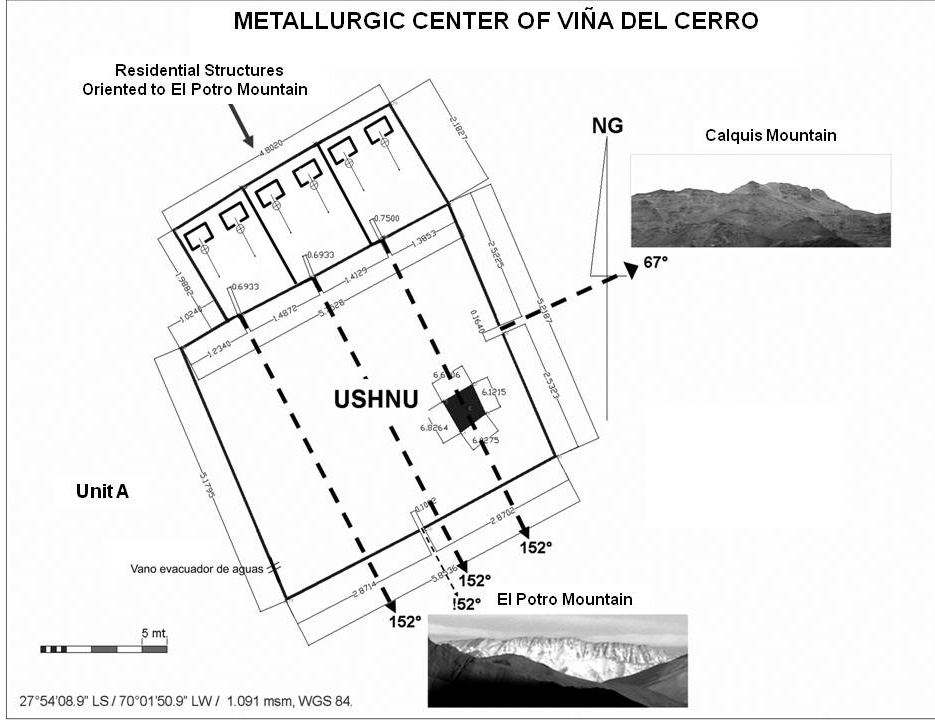
Category of Astronomical Heritage: tangible immovable
Viña del Cerro, Chile

Presentation
Geographical position
Tierra Amarilla, III Atacama Region, northern Chile.
Location
Latitude 27° 54′ 9″ S, longitude 70° 1′ 51″ W. Elevation 1090m above mean sea level.
General description

Fig. 1. Location of Viña del Cerro. Drawing by Ricardo Moyano
Viña del Cerro is a Diaguita-Inka metallurgical centre dating to approximately 1400 AD. The site is located in the middle of the Copiapó river valley, or Camasquil, on a rocky hill at the foot of the Calquis Mountain, near the ancient Indian town of Painegue.
Brief inventory

Fig. 2. See text. Drawing by Ricardo Moyano

Fig. 3. See text. Drawing by Ricardo Moyano

Fig. 4. See text. Drawing by Ricardo Moyano
The site is composed of four well-defined architectural units: a group of huayras (founding ovens), a control unit, a water-provisions construction, and a large plaza or kancha (see Fig. 2). The kancha or unit A, which is located on a large flat section of a rocky hill, is an area of 58.5 × 52 m constructed of mud, stone and adobe. It is composed of two architectural units: the camp and the ushnu platform. The platform is located on the eastern corner of the large plaza or kancha. It is trapezoidal in form, with a 6 m wall of mud and stone. The platform has seven steps that are 1.4 m wide, located on the east side of the south wall.
The access gates to the residential structures and the kancha are oriented towards the summits of two prominent mountains, Potro mountain in the south-east and Calquis Mountain to the north-east (Fig. 3). The ushnu ’s walls and diagonals are also aligned on these mountain peaks, together with the positions of sunrise on the two solstices (line segments 4-1 and 4-2 in Fig. 4. These and other alignments suggest that the platform that was part of the ushnu, and the access doors of the kancha and other structures, could have served for the creation and adjustment of a solar horizon calendar using specific mountains in the local landscape as reference points.
History
In 1958 Jorge Irribarren described what for him were ‘Indian constructions’ and undertook the first topographical survey of this site with the help of Hans Niemeyer, who later began the first archaeological excavations at the end of the 1960s. Between 1979 and 1980, Niemeyer executed a new topographic survey of Viña del Cerro along with another archaeologist. The site was studied from the perspective of archaeoastronomy between 2004 and 2006.
Cultural and symbolic dimension
Ushnus have been interpreted in various ways: as platforms for military parades, places where military leaders swore obedience to the Inca, places for capac hucha ceremonies, places where the Sapa Inca or his representatives spoke about politics and justice, podiums where local authorities carried out their responsibilities, platforms for ceremonies to fertility worship, places for astronomical observations, and centres for architectural planning in the principal provincial towns of the Inca empire.
Analysis of the orientations of the reconstructed architecture at Viña del Cerro provides strong evidence that the site—in addition its to political and administrative functions relating to accounting and to the production of copper and silver—served as a place for performing activities related to sun and mountain worship. In Viña del Cerro, the construction of a complex ushnu may have been a response to the Incas’ need to highlight the pre-existing qualities of the place. These include landscape markers of the solstices, and the visibility of the Calquis and Potro mountains, likely considered sacred places (huacas).
Viña del Cerro is also connected with the ‘Main Incan Trail’, in its section through the Copiapó River Valley between La Puerta and Iglesia Colorada.
Viña del Cerro, with its ushnu, was a place that symbolized the authority of the Inca as well as Andean complementarity and reciprocity. It served as a form of ideological coercion and subordination of local groups to the solar deity and the Inca empire, through the incorporation of all potentially sacred elements from the local topography.
Authenticity and integrity
An architectural restoration was carried out in 1982 by the Institute of Archaeological Investigations and Monumental Restoration of the University of Antofagasta, Chile, under the supervision of Hans Niemeyer.
Management and use
Main threats or potential threats
Human disturbance and natural agents (wind, sun, and water).
Archaeological / historical / heritage research
Viña del Cerro forms part of the World Cultural Heritage project Qhapaq ├æan (Main Andean Trail) of UNESCO and the University of Chile.
Management, interpretation and outreach
The site is a national historical and archaeological zone. Outreach is provided by the Atacama Regional Museum.
References
Bibliography (books and published articles)
- Niemeyer, H. (1986). ’La ocupación incaica de la cuenca alta del río Copiapó (III región de Atacama, Chile)‘, Comechingonia, Número Especial: 165-294.
- Niemeyer, H. and Cervellino, M., eds. (1997). Culturas Prehistóricas de Copiapó. Copiapó: Museo Regional de Atacama.
- Moyano, R. (2009). ’El adoratorio prehispánico del cerro El Potro: arqueología de alta montaña en la cordillera de Copiapó, norte de Chile‘, Estudios Atacameños 39, in press.
- Zuidema, R.T. (2009). El Calendario Inca: Tiempo y Espacio en la Organización Ritual del Cusco; La Idea del Pasado. Lima: Fondo Editorial del Congreso del Perú y Pontificia Universidad Católica del Perú.
No multimedia content published
Currently there is no multimedia content published for this case study









